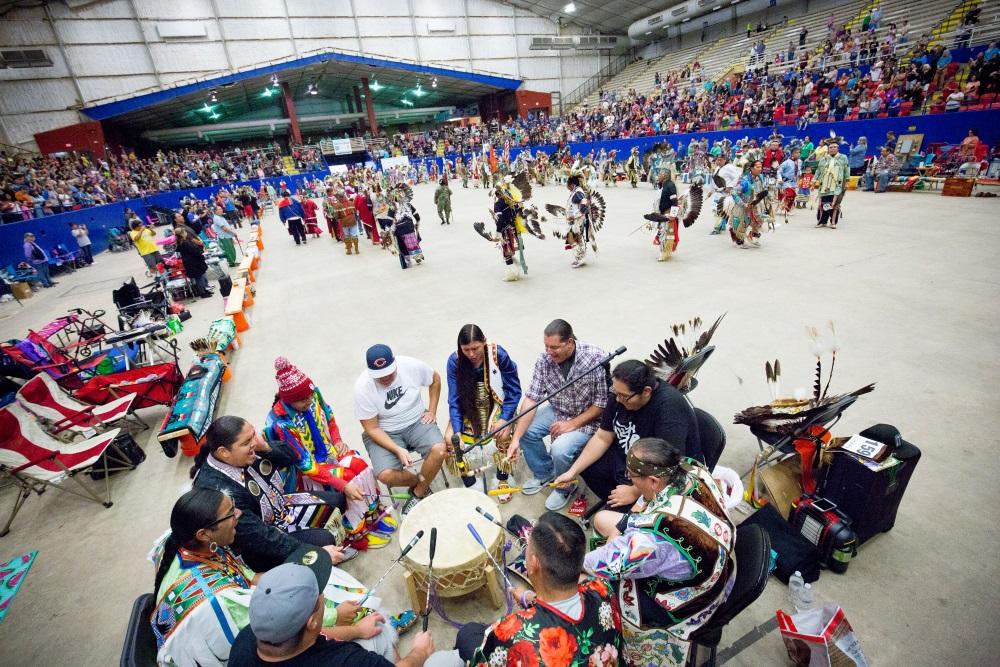In an arena where dance competitions are being held, surrounded by hundreds of spectators sitting in the stands, native men in vibrant colored feathered garments compete in the Men’s Fancy Feather Dance to the echoing beat of a drum circle.
Story by Sarah Ponder
Photo courtesy of Austin Chronicle
“Our history is all we have,” said Jenny Kessler, a board member on the committee for the 28th Annual Austin Powwow and American Indian Heritage Festival. “If we share this, our younger generations can live on.”
An active member of the Great Promise for American Indians, the nonprofit that conducted the festival, Kessler said a lack of indigenous representation in Austin inspired the organization to start the group’s first festival held in Austin. Today, Great Promise supports a mission to preserve traditions and educate the general public about Native American heritage. Held annually, the Austin Powwow has remained one of the largest single-day celebrations in the country.
A powwow refers to a gathering of Native American communities in celebration of indigenous culture through dances, food and the selling of arts and crafts in honor of Native ancestors. Following the relocation of Native American tribes and diffusion of indigenous culture, powwows became a way for Native Americans to continue passing down traditions to later generations. Present-day powwows, similarly, emphasize the importance of the preservation of Native traditions while shedding a positive light on Native culture to outsiders.
Modern-day powwows are thought to derive from inter-tribalism that occurred during the reservation period in the United States. Interactions among different tribes increased as communities were forced closer together. This led to the transferring of traditions, cultural collaboration among tribes and eventually the creation of a new tribal identity. Styles of dance, music, food and art were influenced by one another until new adaptations formed. With urbanization, events that became what we know now as powwows were held in large cities across the United States.
“My father brought me to powwows and ceremonies. It gives wholeness to your spirit,” Kessler said discussing how native dances, songs and rituals are passed on. “Especially for indigenous kids— it’s easy to get lost. [Powwows] give kids a place to express themselves.”
Aisles of vendors were set up at the event, selling traditional native crafts. Everything from dream catchers to jewelry, shawls, blankets, wooden flutes and traditional clothing pieces could be found walking through each stand.
Stephanie Hebert, owner, and beadworker of Talon Beading Company was a vendor at the festival. Moving to Texas from Nova Scotia, Canada —where her tribe is from— she said she just recently became a vendor, selling beaded work inspired by the designs of her mentor. Much like Kessler, Herbert said powwows have always been part of her life growing up. Aside from making beaded pieces, she also competes at powwow events as a jingle dancer.
“I’m carrying the traditions of my mother and grandmother forward for generations that will never get a chance to meet them,” Hebert said. “But, they will know their spirits through my art.”
Events such as the Austin Powwow give Native people the chance to honor their past ancestors while also helping to unify the indigenous community as a whole despite major changes affecting Native culture.
This month, President Donald Trump made an announcement that outraged many. November, a month that is most notably known as Native American Heritage Month, was to be renamed as National American History and Founders month instead. For as long as the fight for culture preservation has existed, it only makes sense why this would be viewed as another attempt at erasing an aspect of Native American history. However, despite this, Kessler said that through the celebration and education of indigenous culture in powwows, the history of her ancestors will continue to live on.
“Every single person walks with their ancestors,” she said. “When we live, they live. We have to remember the past to carry on for our future.”












































